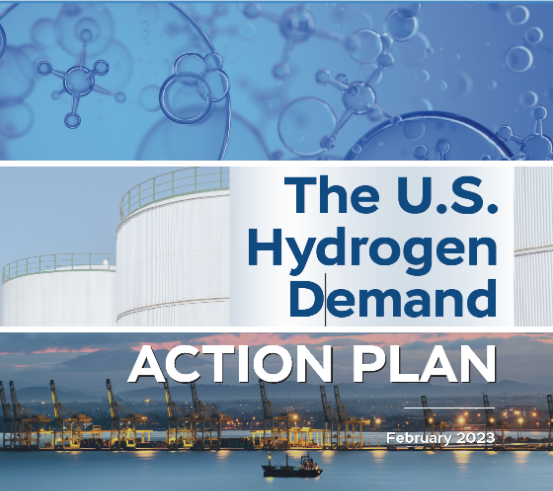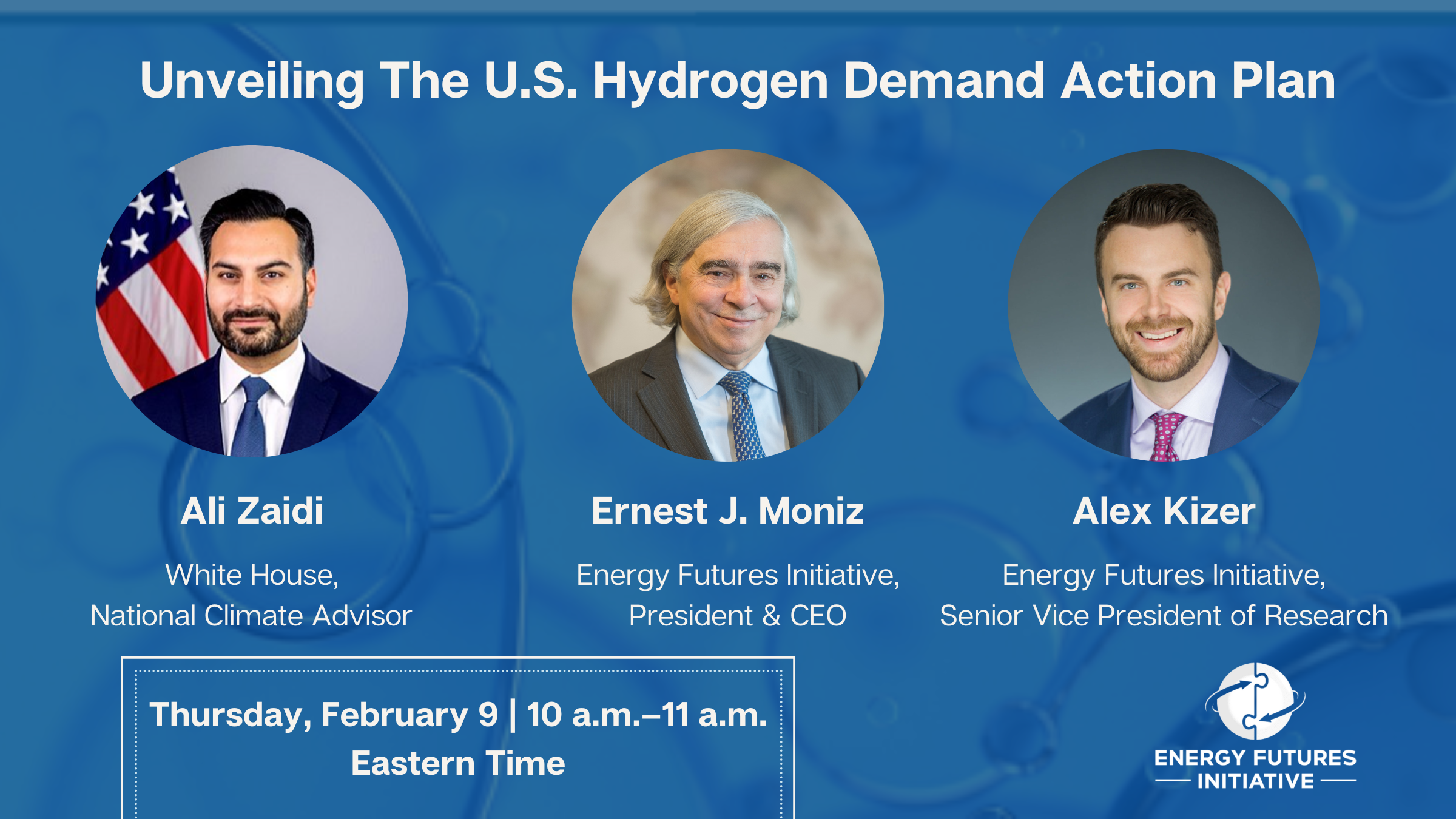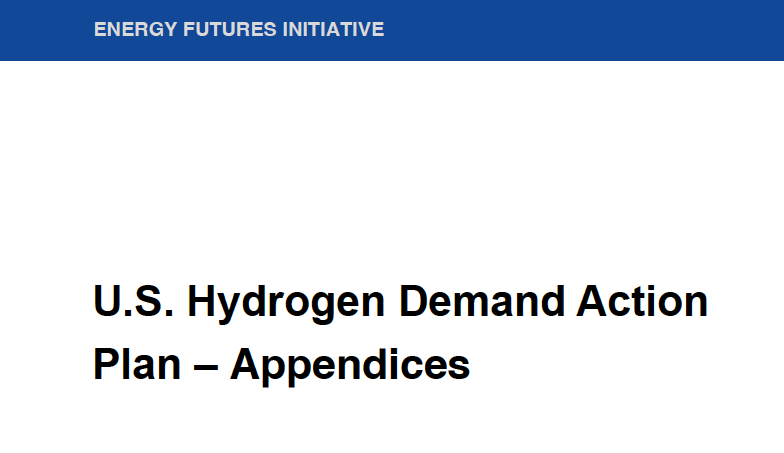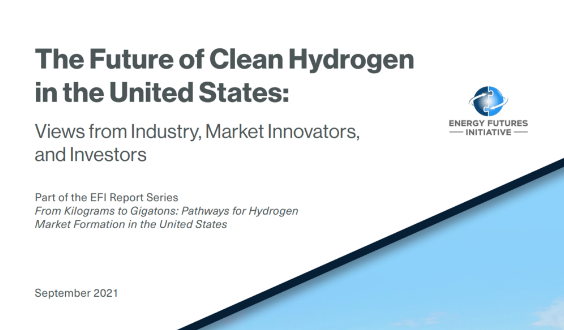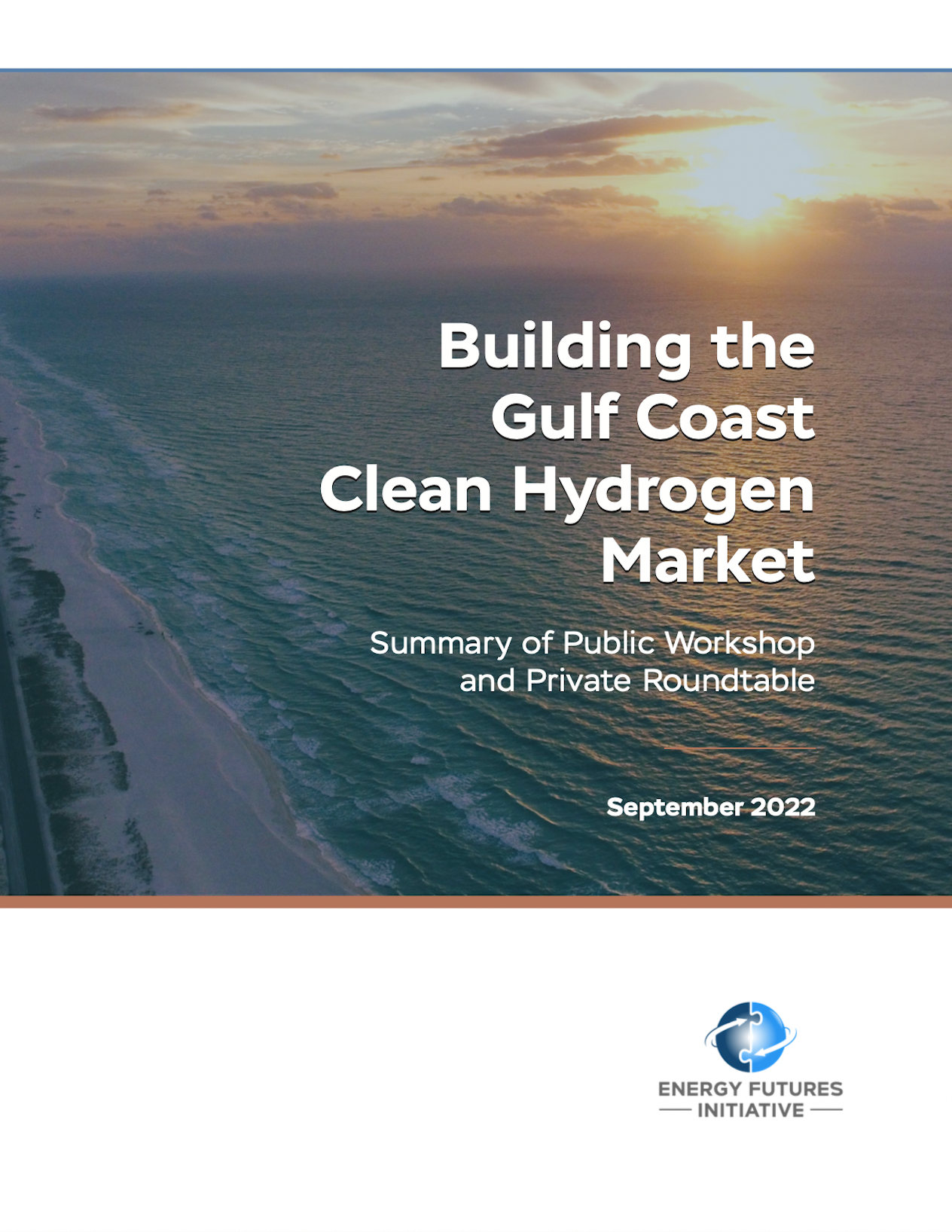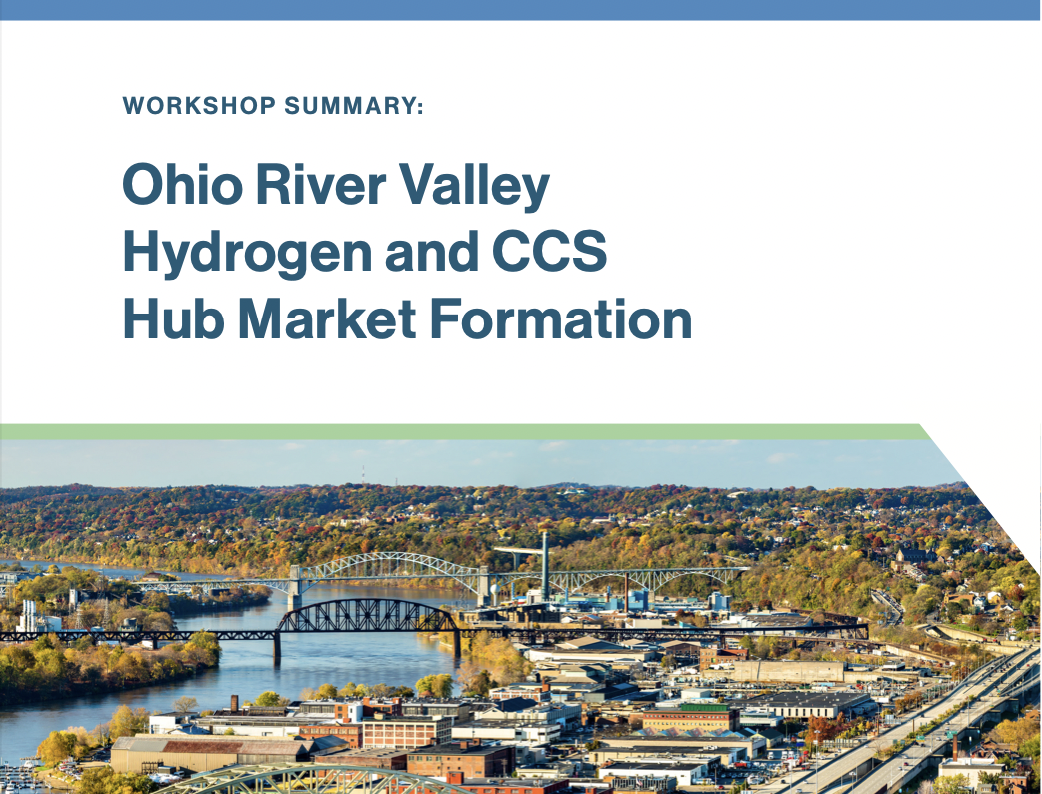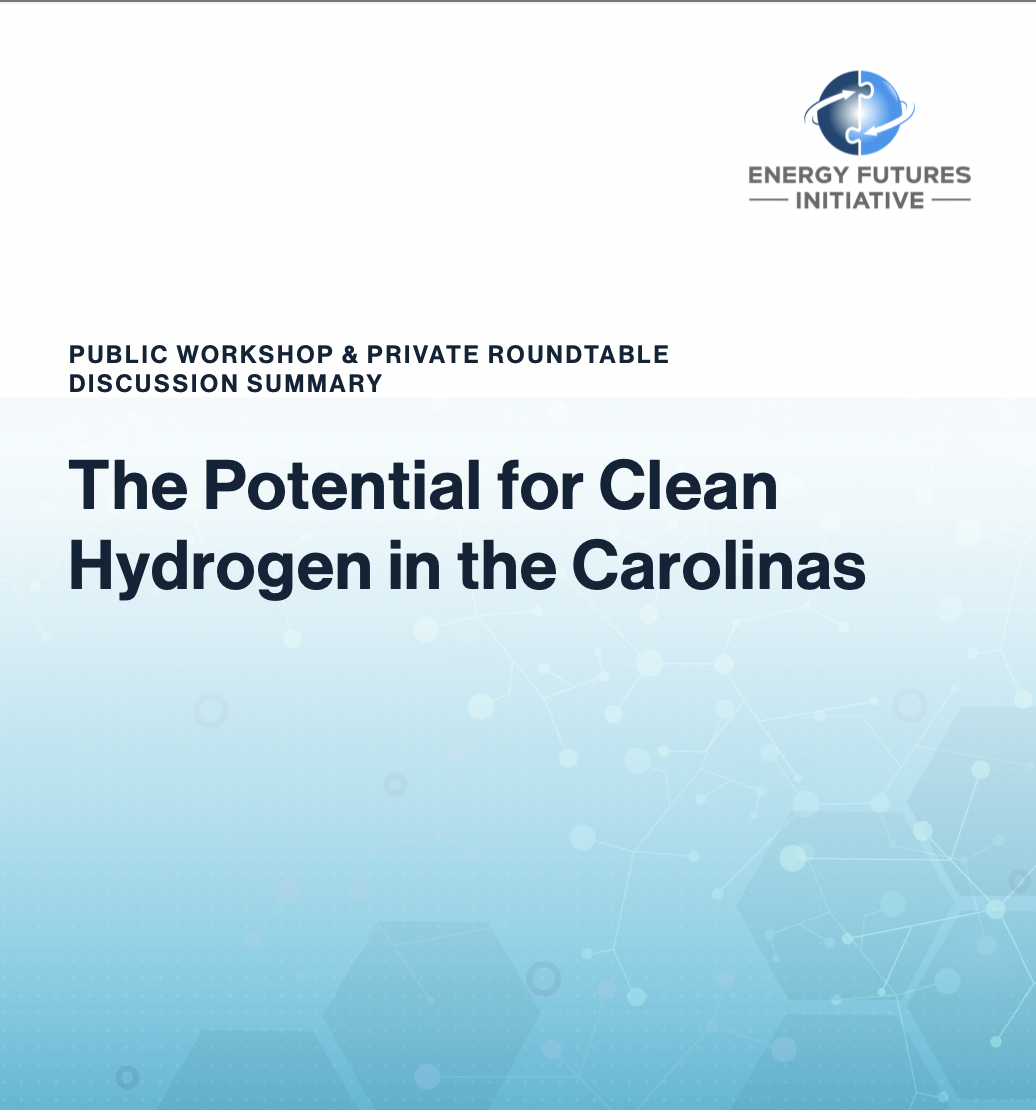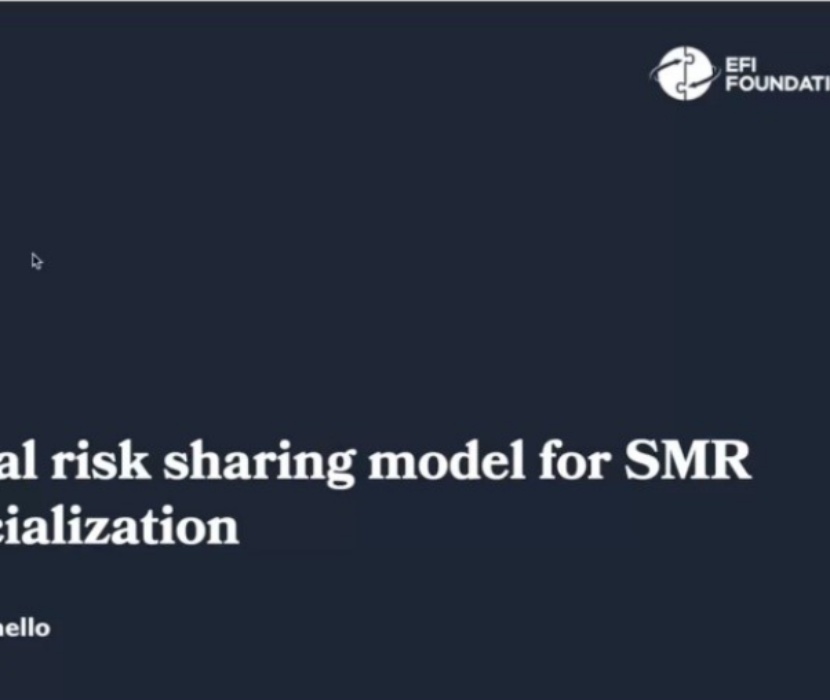
Now is a time of unprecedented policy momentum for clean hydrogen in the United States. The Bipartisan Infrastructure Law and the Inflation Reduction Act are providing tax credits, incentives, and billions of dollars for research and development and regional clean hydrogen hubs. While these laws are expected to drive down the costs of clean hydrogen, a clean hydrogen industry is not yet on the horizon—at least not without an action plan for stimulating U.S. hydrogen demand.
On February 9, 2023, the Energy Futures Initiative (EFI) released The U.S. Hydrogen Demand Action Plan, a new study that presents a pathway for rapidly accelerating hydrogen use across regions and sectors from more than two years of EFI research on hydrogen market formation. This work included a study of U.S. hydrogen market investments, three workshops with regional hydrogen hub stakeholders in the Gulf Coast, the Carolinas, and the Ohio River Valley, and hundreds of interviews with thought leaders in industry, government, and academia.
EFI CEO Ernest Moniz and White House National Climate Advisor Ali Zaidi headlined the report rollout event, followed by a study overview from Alex Kizer (EFI senior vice president of research) and stakeholder commentary from Janice Lin (Founder and CEO, Strategen) and Brad Markell (Executive Director, Industrial Union Council, AFL-CIO). As part of the event, EFI also introduced The Hydrogen Transition Framework (HyTF), a new, publicly available, analytical tool designed for the study to aid policymakers and project developers in their roles in hydrogen market formation.
Federal Efforts to Advance a Clean Hydrogen Industry
White House National Climate Advisor Ali Zaidi lauded our country’s progress on hydrogen market formation, and explained efforts underway in the Biden administration to continue to move it forward.
“Where we are today [on hydrogen capital formation] is almost an unimaginable level of progress relative to where we would have imagined we’d be even five years ago,” Zaidi said. He added that we are “poised not just to get in the race,” but “really to step the United States up to be a [global] leader in driving forward the deployment of clean hydrogen in the service of our climate and energy security goals.”
As an example, Zaidi cited recent private sector action: the announcement by Air Products and AES to invest $4 billion to build the first green hydrogen production facility in Texas. And for the private sector, he said the Biden administration is aiming to leverage the Bipartisan Infrastructure Law and the Inflation Reduction Act as part of a national hydrogen strategy with the U.S. Department of Energy to drive the production of 10 million metric tons of hydrogen by 2030.
He said at the heart of these many policies are (1) the $8 billion in the Bipartisan Infrastructure Law for developing regional hydrogen hubs across the country and (2) a suite of tax credits—the hydrogen production tax credit, as well as the 48C tax credit that focuses on manufacturing technologies that will produce clean hydrogen. Zaidi said we can expect to see more detail on the 48C tax credit in the next month and more detail on the hydrogen production tax credit in several months. For hydrogen hubs, Zaidi gave the update that the concept paper application state has received 79 submissions, proposing $157 billion of private capital investment alongside federal funds.
“President Biden’s clean hydrogen strategy really focuses itself around using this tool [hydrogen] as an accelerant towards reaching our net-zero emissions across the economy,” Zaidi said. “We’re trying to get there by no later than 2050… [with] a renaissance in American manufacturing.”
Zaidi pointed to statistics that President Biden shared in that week’s State of the Union address about 800,000 new manufacturing jobs in the United States.
“We have to do the hard work of scaling up the utilization of this fuel clean source that in a way that instills confidence in our communities and that listens to the folks who will be at the fenceline of these production facilities,” he said.
Zaidi added that the Biden administration is supporting a research roadmap that is focused on continuing to drive down the hydrogen technology cost curve: the U.S. Department of Energy’s Hydrogen Shot goal is $1/kilogram within a decade for clean hydrogen. And, Zaidi said the Biden administration is bringing together not only the U.S. Department of Energy (DOE) but other federal agencies—including the U.S. Department of Defense, the U.S. Department of Transportation, and the U.S. Department of Housing and Urban Development—to accelerate the adoption of clean hydrogen.
Zaidi said we have to “finish the job,” referencing President Biden’s State of the Union. “We are not done. Clean hydrogen is not all the way there in terms of the full potential [of] being ready to be harnessed across the economy,” Zaidi said.
Demand Action Plan for Hydrogen
EFI senior vice president of research Alex Kizer presented the findings of EFI’s new hydrogen study, which gives an action plan for moving “finishing the job” and building from the cost reductions that are expected to result from recent legislation to the demand needed to deploy a clean hydrogen industry.
Kizer focused on four study conclusions: (1) Clean hydrogen projects reveal there is enormous interest in taking part in the emerging hydrogen market, and there are many entry-level applications. (2) Inflation Reduction Act incentives significantly lower the cost of clean hydrogen production, building a strong foundation but requiring more action for demand formation. (3) Implementing the Inflation Reduction Act should encourage flexible, phased approaches to life-cycle emissions compliance, supporting first movers that are creating demand. (4) Supporting regional hydrogen hubs is the principal policy that specifically targets market formation, and implementing these hubs will de-risk many critical market issues, such as permitting.
To the first point, Kizer discussed how the action plan was based on interviews with investors in 2021 about why they had or had not decided to invest in hydrogen.
“A major insight here was that many of these firms are making decisions based mostly on just how they can move quickly up the hydrogen learning curve, as opposed to finding long-term plays,” he stated.
This means that while many investors and companies are making entry-level investments, those are not currently building out into wider markets. The Inflation Reduction Act should help drive down hydrogen production costs, decreasing supply-side concerns. However, Kizer spoke to the challenges that remain on the demand side of the market.
“A common thread throughout all this work was concerns over how to activate the demand side, specifically finding bankable off takers for new clean hydrogen supplies,” he said. “This motivated the action plan.”
EFI’s report gives detailed policy recommendations for driving demand for national hydrogen market formation. Kizer said these recommendations are “strategies for implementation aimed at supporting domestic markets.” One of these recommendations is for Congress to increase funding for the U.S. Department of Energy’s hydrogen hubs program and create robust information-sharing requirements. Hydrogen hubs stimulate market demand by allowing participants to pull resources jointly, manage costs, and coordinate infrastructure development. He also said hydrogen hubs should have “robust information sharing” to ensure that knowledge is passed on to improve the operation of future projects in the industry. He also added that regional hydrogen hubs could derisk market development challenges, which would have a specific and positive effect on demand.
“Regional clean hydrogen hubs…are one of the only major federal policy programs that really targets demand,” Kizer explained.
Another recommendation is for the U.S. Internal Revenue Service to develop a timely and phased approach to issuing guidance on the 45V tax credit. Other recommendations are to prioritize local and regional workforce development and community benefits in DOE’s hydrogen hubs program, to expand hydrogen research and development, and to prioritize infrastructure permitting and U.S. supply chains development.
“Reaching net zero in less than 30 years depends on successfully reaching scale while navigating certain boundary conditions of the energy sector that make it historically slow to change,” Kizer said. “The transition to net zero emissions will depend on an unprecedented transition of the U.S. workforce, and strong alignment of projects with frontline and environmental justice communities.”
Stakeholder Perspectives
Next, Janice Lin (founder and CEO of Strategen) and Brad Markell (executive director of the Industrial Union Council at the American Federation of Labor and Congress of Industrial Organizations [AFL-CIO]) discussed ways to continue successfully advancing hydrogen market formation.
Lin said hydrogen hubs are essential to enabling demand, and “silo busting” regulations for infrastructure are also necessary. She explained how we need shared infrastructure—especially pipeline transport with connection to geologic storage and salt domes—to have the “low delivery cost and the assured supply to enable accelerated uptake” of clean hydrogen. She also stated that creating this shared infrastructure would provide opportunities to include frontline communities and that by working together, we could move forward quickly.
“I would just offer that to go fastest we need to go together in alignment,” Lin said.
Markell drew attention to permitting reform—a challenge that slows down a variety of clean energy technology projects. He said that unless more of these projects can move forward, it will be difficult to mitigate the worst effects of climate change.
“If we don’t get permitting reform… we’re not going to meet our clean energy goals and we’re not going to… beat the climate crisis as quickly as we should,” Markell said.
EFI CEO Ernest Moniz opened and closed the event with optimism around the path forward.
“I would say that the discussions today have been very encouraging that those coalitions to advance hydrogen are there to be built,” he said. “We have a fabulous foundation [with the Bipartisan Infrastructure Law and the Inflation Reduction Act], and now we got to finish the job.”
– Georgia Lyon, Communications Associate
with contributions from the EFI Communications Team
Supplemental Material
Related Content
(Share this post with others.)


